Reliable Wireless Fuel Monitoring for Marine Applications
The MasterCAN S7 NMEA Data Converter is a small, easy-to-use device. It connects wireless fuel sensors to marine electronics using the NMEA 2000 communication system. Engineered for harsh marine environments. Firstly, it provides accurate, real-time data on fuel consumption, temperature, and engine runtime. Achieved by converting wireless data from our supplier’s BLE-enabled fuel flow meters into standard NMEA 2000 messages. Making it an essential tool for vessel owners, captains, and marine engineers looking to optimise fuel usage and maintenance schedules.
🔧 Features of the NMEA Data Converter:
Seamless Wireless Integration:
Receives fuel flow, temperature, and engine runtime data. From DFM S7 or DFM Marine S7 meters via Bluetooth Low Energy (BLE 4.2).Standard NMEA 2000 Output:
Converts BLE data to NMEA 2000 PGNs (Parameter Group Numbers). Therefore, ensuring compatibility with chart plotters, MFDs, and other onboard systems.Easy Setup with Mobile App:
Configure and manage settings via the Service S7 NMEA mobile app (Android), with intuitive Bluetooth pairing and calibration.Rugged Marine-Grade Construction:
IP68-rated enclosure built for demanding sea conditions with an operating range from -40°C to +85°C.Low Power Consumption:
Efficient design with power draw as low as 70 mA at 24V. Therefore, ideal for vessels operating with limited power reserves.Tamper-Resistant Design:
Secure housing with unique ID seal prevents unauthorized adjustments, ensuring trusted data capture.
⚓ Applications:
Marine Fuel Monitoring Systems:
Integrates with vessel systems to track hourly and total fuel consumption for engines, generators, or boilers.Fleet and Vessel Telematics:
Enables data-driven decision-making for tugs, ferries, dredgers, and cargo ships. Achieved by feeding real-time fuel and engine data into telematics platforms.Maintenance Scheduling:
Uses actual engine hours and performance data to plan servicing, reducing downtime and increasing operational efficiency.Fuel Theft and Leak Detection:
Continuous monitoring of fuel consumption patterns helps identify anomalies and prevent losses.Energy Efficiency Optimisation:
Supports captains and operators in reducing fuel usage and emissions. Achieved by analysing live fuel data alongside route and sea conditions.
Integrating Flow Meters with Ship Displays via NMEA 2000

Connecting DFM fuel flow meters to standard onboard displays using the NMEA 2000 interface allows the ship’s crew to:
Accurately monitor fuel consumption of propulsion engines, diesel generators, and other fuel-powered systems
Track engine, generator, and boiler operating hours
Estimate cruising range and plan refuelling (bunkering) more effectively
This data helps ensure the reliable operation of key equipment and supports accurate reporting on the ship’s performance and fuel usage.
Optimise marine fuel efficiency and equipment lifespan with the MasterCAN S7 — the advanced NMEA Data Converter purpose-built for wireless, real-time vessel monitoring.
How the S7 NMEA Data Converter and Fuel Flow Meters Work in an NMEA 2000 Network
The MasterCAN S7 NMEA Data Converter receives wireless data from one or two DFM S7 fuel flow meters via Bluetooth Low Energy (BLE). It then converts this information into NMEA 2000 messages, making it compatible with onboard marine displays and systems. If the vessel is equipped with a telematics unit—such as a GPS tracker or black box—the data can also be transmitted to a remote server for further analysis.

Differential Fuel Consumption Monitoring
When used to measure differential fuel consumption, the MasterCAN S7 NMEA calculates the difference between the fuel supply and return flow rates. It then transmits this already-processed value over the NMEA 2000 network. So there’s no need for additional calculations on the display or telematics system.
Simple, Accurate Operation
There’s no need for manual calibration between the two fuel flow meters. Each DFM S7 flow meter operates independently, with its own processor that measures fuel flow in real time. This ensures accurate and reliable data for monitoring fuel efficiency and system performance.
Specifications
- Input Interface – Bluetooth 4.2
- Output Interface – CAN (NMEA 2000)
- Maximum Current Consumptions at Supply Voltage 12/24V – 130/70mA
- Operating Temperature – -40 to +85°C
- Ingress Protection code – IP68
- Maximum Weight – 0.2 kg
- Dimensions (L x W x H) – 128 x 70 x 52mm
- Interface Cable Length – 940 mm
Contact our team for more information.




